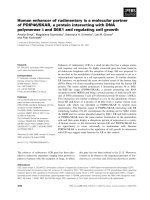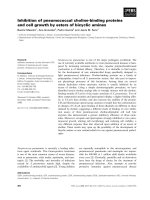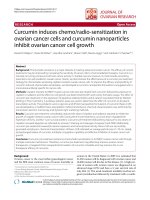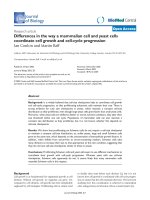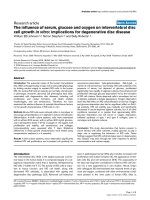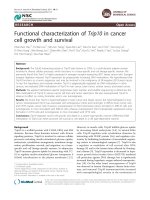Metabolism Fueling Cell Growth
Bạn đang xem bản rút gọn của tài liệu. Xem và tải ngay bản đầy đủ của tài liệu tại đây (1.88 MB, 36 trang )
Chapter 6:
Metabolism:
Fueling Cell
Growth
Chapter 6 Notes
Don’t worry too much about the
details of Glycolysis, Cellular
Respiration, or Photosynthesis
onward.
These topics are covered on pp.
144-151 and pp. 156-163.
Note, however, that we will cover
Glycolysis and Cellular Respiration
in class at least from the
perspectives of the importance of
NAD+ regeneration.
Important Point:
Products of Microbial Metabolism
Important Consequences
of Microbial Metabolism
Beer, wine, and other alcoholic beverages.
Bread (all of above are mostly products of the yeast
Saccharomyces cerevisiae).
Products of lactic-acid bacteria (LAB) including sour
milks, various cheeses, half-sour pickles, sauerkraut,
etc. (e.g., of Lactococcus spp. & Lactobacillus spp.).
Organic solvents including acetone (product of
Clostridium acetobutylicum), butanol (ditto), and, of
course, ethanol (product of S. cerevisiae).
Acetic acid (vinegar).
Biochemical identification of bacterial species.
Unique (e.g., not found in animals) targets for
antimicrobial action.
Disease (e.g., dental caries).
Metabolism =
Catabolism + Anabolism
sum = metabolism
Pay
particular
attention
to those
words in
bold in
this
figure.
Bioenergetics (see Fig. 6.3)
More generally, sun or
reduced inorganic
chemicals (ocean vents).
More generally,
photoautotrophs (or
just autotrophs).
E.g., glucose
More generally,
chemoheterotrophs.
Note that bacteria
don’t have
mitochondria:
aerobic bacteria
“are” mitochondria!
Metabolism Terms & Concepts
Metabolic pathway = highly evolved intracellular
sequence of chemical reactions.
Each step of a metabolic pathway usually is
enzymatically catalyzed (and enzymes are proteins).
Substrates are molecules that enter into
enzymatically catalyzed reactions.
Products are what substrates are enzymatically
converted into.
Enzymes typically are very precise in terms of what
substrates they will accept (often no more than one
specific chemical) and they will convert a substrate
into (often no more than one specific chemical).
Precursor molecules are found at the start of
metabolic pathways.
Intermediate molecules are found within metabolic
pathways.
End products are the molecules ultimately produced
by a given metabolic pathway.
Chemical Energetics
How cells
“burn” glucose.
Enzyme Terms & Concepts
Enzyme names generally are indicated by an “ase” ending, e.g., dehydrogenase (lysozyme is
exception).
Enzymes have active sites (a.k.a., catalytic
sites).
Cofactors are non-protein components of
enzymes; they can be organic or inorganic.
Coenzymes are organic cofactors; they generally
are carriers of other molecules or ions.
NAD+ for example is a coenzyme.
Ezyme with Cofactor
Environment Impact on Enzyme Activity
Enyzmatic Inhibition
Variation on Metabolic Pathways
Variation on Metabolic Pathways
Glycolysis is a catabolic pathway.
E.g., ATP, CO2,
and NADH.
Krebs citric acid
cycle is a cyclic
catabolic
pathway.
ATP – Energy Currency of Cells
ATP, ADP, and Metabolism
Oxidation-Reduction (Redox)
Oxidation-Reduction (Redox)
Oxidation-Reduction (Redox)
Note NAD+
(not “NAD”).
Note that 2 hydrogen ions are
removed along with the 2
electrons (only one H+ ends
up attached to NAD+, hence
the charge change).
Overview of Metabolism
An Enzyme and Coenzyme Mediated Catabolic Pathway
Glycolysis (see Fig. 6.14)
Glucose
NAD+
NADH
ATP
ATP
Pyruvate
An Enzyme and Coenzyme Mediated Catabolic Pathway
Glycolysis (see Fig. 6.14)
An Enzyme and Coenzyme Mediated Catabolic Pathway
Glycolysis (see Fig. 6.14)
Glucose
NAD+
NADH
ATP
ATP
Pyruvate
Regeneration of NAD
+
